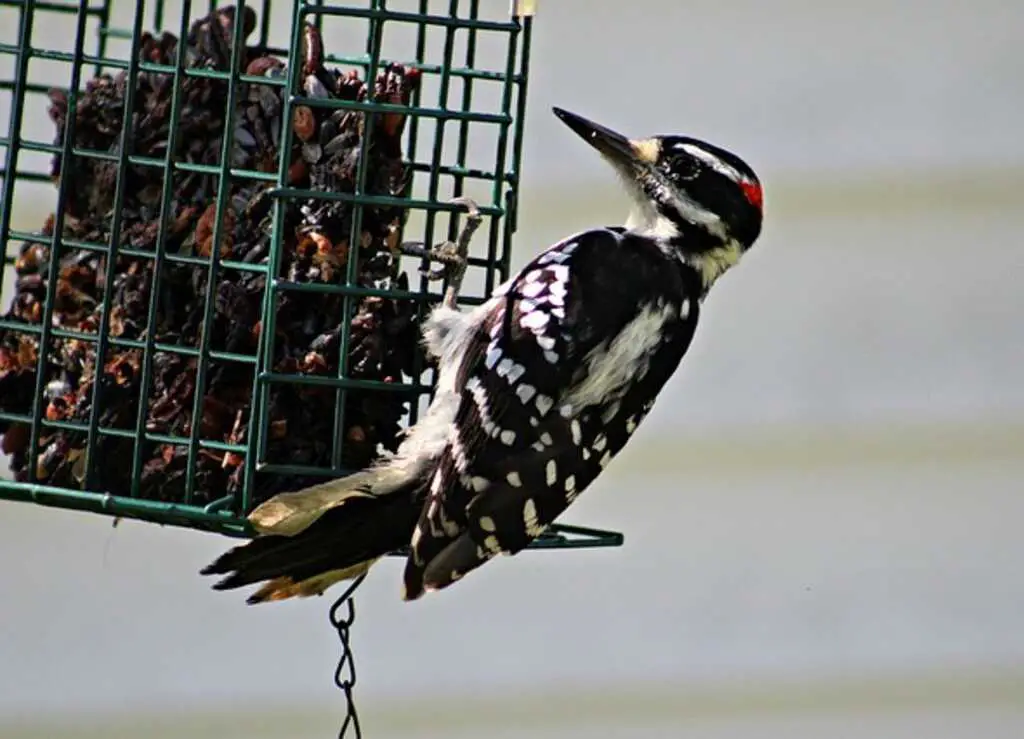Colorado’s diverse landscapes provide a haven for a wide variety of bird species, including an impressive array of woodpeckers. In this ultimate guide, we dive into the fascinating world of woodpeckers in Colorado, exploring 13 distinct species. From the iconic Northern Flicker to the elusive Lewis’s Woodpecker, join us on a journey through the Centennial State’s woodpecker population.
Table of Contents
- 1 Types of Woodpeckers in Colorado
- 1.1 Northern Flicker
- 1.2 Downy Woodpecker
- 1.3 Hairy Woodpecker
- 1.4 Red-naped Sapsucker
- 1.5 Lewis’s Woodpecker
- 1.6 Williamson Sapsucker
- 1.7 Red-headed Woodpecker
- 1.8 American Three-toed Woodpecker
- 1.9 Ladder-backed Woodpecker
- 1.10 Red-bellied Woodpecker
- 1.11 Yellow-bellied Sapsucker
- 1.12 Acorn Woodpecker
- 1.13 Red-breasted Sapsucker
- 2 Author
Types of Woodpeckers in Colorado
Northern Flicker
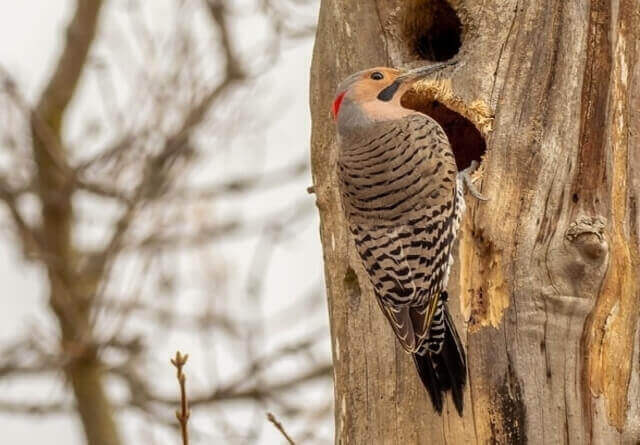
- Length: 11.0-12.0 in (28-31 cm)
- Weight: 3.9-5.6 oz. (110-160 g)
- Wingspan: 16.5-20.0 in (42-51 cm)
- Scientific Name: Colaptes auratus
- Frequency of Occurrence: 35.12% (Statistic by: eBird)
- Maps: Range map – Sightings map
- Sounds: Calls and songs
- Where To Find Them: There are many places that offer prime bird watching opportunities for catching glimpses of Northern Flickers in Colorado. Rocky Mountain National Park is one such spot, with miles of trails suitable for spotting these amazing creatures. Other areas such as Grand Mesa, San Juan National Forest and Rio Grande National Forest also provide great opportunities to observe flickers in their natural habitat. Local parks like Washington Park and City Park, located near Denver, are also good spots for seeing these colorful birds.
- How To Attract: To attract Northern Flickers to your yard, provide them with food such as suet, sunflower seeds. You can use a woodpecker-specific feeder, such as the Gray Bunny Sunflower Seed and Peanut Feeder, the Woodlink Going Green Platform, or the Kingsyard Woodpecker Suet Cake Feeder, to offer these foods. Place feeders in a location that is easy for the birds to access, like near a window or in an open area of the yard. Offer water sources such as birdbaths or shallow bowls filled with fresh water. Provide nesting boxes near trees and construct perches nearby for the birds.
Description: The Northern Flicker, or Colaptes auratus, is a species of woodpecker native to North America. This species has a large distribution range, spanning across most of the United States and Canada. It prefers grassy woodland and open areas such as pastures or fields, with plenty of trees and shrubs for nesting materials. Its diet consists mainly of ants and beetles, which it finds while digging in the ground with its long beak.
It also eats nuts, seeds and fruits when available. These birds are known for their distinctive drumming on trees to create cavities for nesting. Both male and female will work together to create these cavities in dead trees or tree stumps during the breeding season. The Northern Flicker offers an interesting example of adaptation that has allowed this species to survive over time.
Related: How to Attract Northern Flickers to your Backyard? (Easy)
Downy Woodpecker
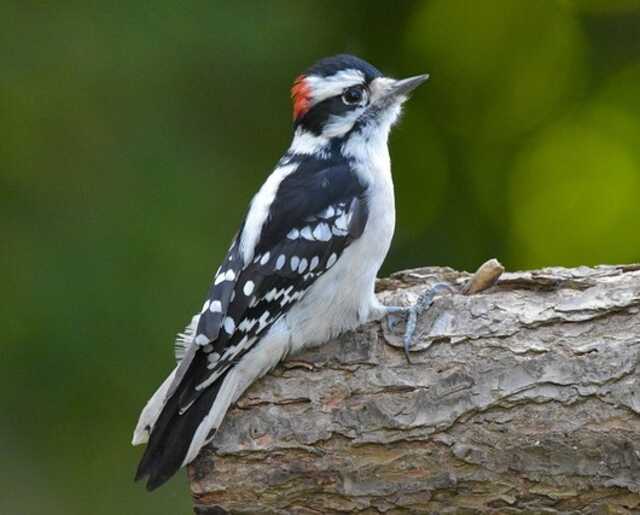
- Length: 5.5-6.7″ in (14-17 cm)
- Weight: 0.7-1.0 oz. (21-28 g)
- Wingspan: 9.8-11.8″ in (25-30 cm)
- Scientific Name: Picoides pubescens
- Frequency of Occurrence: 14.36%
- Maps: Range map – Sightings map
- Sounds: Calls and songs
- Where To Find Them: If you’re looking for Downy Woodpeckers in Colorado, there are several places to look. Breckenridge is one of the best spots for birding enthusiasts to see Downy Woodpeckers in the state. This area is especially popular with those who enjoy outdoor activities like skiing and hiking, as it offers spectacular views of the Rocky Mountains. Breckenridge is also home to an abundant population of Downy Woodpecker s that can often be spotted near dead or dying trees, where they feast on larvae and berries.
- How to Attract: To attract Downy Woodpeckers to your yard, use woodpecker-specific feeders such as the Gray Bunny Sunflower Seed and Peanut Feeder, the Woodlink Going Green Platform, or the Kingsyard Woodpecker Suet Cake Feeder, to offer suet, sunflower seeds, and mealworms. Place a bird bath in your yard and provide natural food sources by planting bushes and trees that produce insects and berries. Consider installing a nesting box appropriate for the species, and make sure to follow guidelines for the size and shape of the box and its location. By providing food, water and shelter, you’ll be able to attract Downy Woodpeckers to your yard.
Description: The Downy Woodpecker (Picoides pubescens) is a small bird found throughout North America, ranging from Alaska and Canada down to Nicaragua. It inhabits open woodlands, parks and gardens with trees, as well as edges of forests and thickets. Its diet mostly consists of small insects, their larvae and spiders, which it obtains by probing in tree bark for its food.
As for nesting, the female lays four to five white eggs inside a round hole in dead trees or snags. The male then incubates the eggs, while both parents feed the young when they hatch. Both sexes also excavate cavities in dead trees, on which they sometimes roost at night. The Downy Woodpecker has adapted well to human habitations, making them one of the most widespread species among North American birds.
Related: How to Attract Downy Woodpeckers to Your Yard? (Easy!)
Hairy Woodpecker
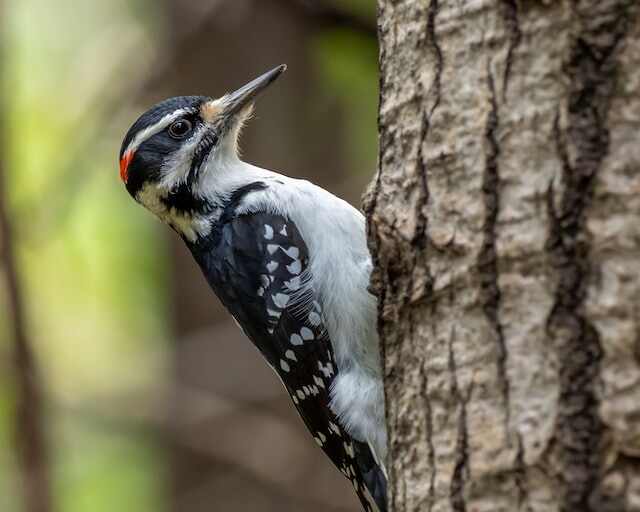
- Length: 7.1-10.2 in (18-26 cm)
- Weight: 1.4-3.4 oz. (40-95 g)
- Wingspan: 13.0-16.1 in (33-41 cm)
- Scientific Name: Picoides villosus
- Frequency of Occurrence: 5.61%
- Maps: Range Map – Sightings Map
- Sounds: Calls and songs
- Where To Find Them: Most Hairy Woodpeckers will be located near coniferous forests such as pine or spruce trees. These trees provide food sources for the birds, such as insects and larvae that live beneath the bark or in dead wood. In Colorado, these can be found at higher elevations throughout the mountains and foothills regions of the state. National parks such as Rocky Mountain National Park, Great Sand Dunes National Park and Preserve, San Isabel National Forest, and Indian Peaks Wilderness area are all great places to look for Hairy Woodpeckers.
- How to Attract: To attract Hairy Woodpeckers to your yard, use a variety of feeder types such as tube feeders, platform feeders, suet feeders, and woodpecker-specific feeders like Heath Outdoor Products Suet Feeder, the Brome Squirrel Buster Plus Wild Bird Feeder, the Songbird Essentials Large Hopper Feeder, and the Stokes Select Suet Feeder to offer a variety of food options. Additionally, place a bird bath in your yard, and provide natural food sources by planting bushes and trees that produce insects and berries. Furthermore, consider installing a nesting box appropriate for the species.
Description:The Hairy Woodpecker is a species of bird found in North America. It has an extensive range, covering much of Canada and the United States, as well as parts of Mexico. They prefer habitats with large trees and open woodlands which are suitable for nesting, such as deciduous or mixed forests. Their diet consists mainly of insects and their larvae, particularly carpenter ants, but they will also eat berries and nuts when available.
When it comes to nesting, Hairy Woodpeckers tend to form monogamous pairs that occupy the same territory year after year. The pair digs out a cavity in a tree where they will lay eggs up to five times during breeding season. In addition to providing protection from predators, these cavities can be reused by other woodpecker species, making them integral components of many ecosystems.
Red-naped Sapsucker
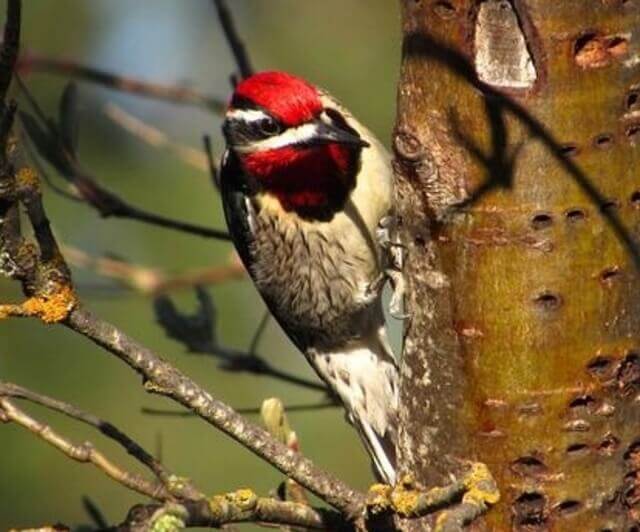
- Length: 7.1-8.7″ in (18-22 cm)
- Weight: 1.1-2.3 oz. (32-65 g)
- Wingspan: 15.7-17.3″ in (40-44 cm)
- Scientific Name: Sphyrapicus ruber
- Frequency of Occurrence: 1.32%
- Maps: Range map – Sightings map
- Sounds: Calls and songs
- Where To Find Them: If you’re looking to spot a Red-naped Sapsucker in Colorado, you might have luck in the southern part of the state. This species is typically found in areas of open coniferous forest and are especially fond of high-elevation areas. Some prime spots to see them include Grand Mesa, Tarryall Mountains, San Juan Mountains and Rio Grande National Forest.
- How To Attract: To attract Red-naped Sapsuckers to your yard, use a variety of feeder types such as tube feeders, platform feeders, suet feeders and woodpecker-specific feeders like the Kingsyard Woodpecker Suet Feeder, the Drolls Yankees Peanut Feeder, or the Stokes Select Sunflower Seed Feeder to offer suet, peanuts or sunflower seeds. Provide a bird bath, natural food sources and a nesting box. Keep the feeder types varied to attract a variety of birds and keep them interested.
Description: The Red-naped Sapsucker is a species of woodpecker found in North America and parts of Central America. Its range stretches from Alaska to northern Mexico and as far east as the Dakotas and Ontario. The bird likes to live in open coniferous forests, especially those with pines, spruce, and Douglas fir trees. Its diet consists mainly of sap, insects, berries and small fruits such as cherries, raspberries and serviceberries.
During nesting season they can be seen drilling characteristic rows of shallow holes into tree bark which they use to drink sap or capture insects. They also sometimes feed on ants by hammering out a regular series of holes in dead or dying trees. The Red-naped Sapsucker is an impressive sight that adds color to any forest landscape!
Lewis’s Woodpecker
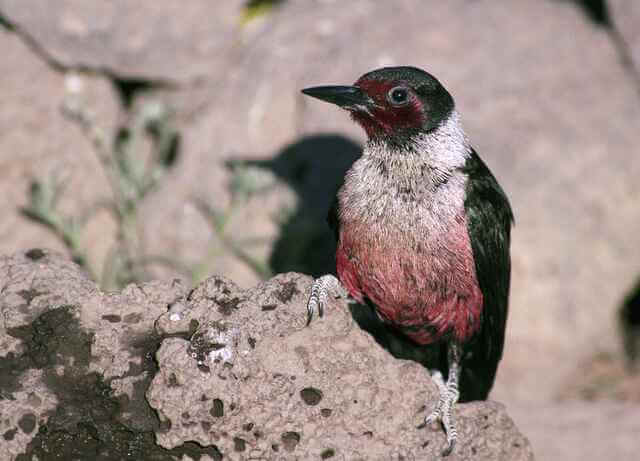
- Length: 10.2-11.0 in (26-28 cm)
- Weight: 3.1-4.9 oz. (88-138 g)
- Wingspan: 19.3-20.5 in (49-52 cm)
- Scientific Name: Melanerpes lewis
- Frequency of Occurrence: 0.8206%
- Maps: Range Map – Sightings Map
- Sounds: Calls and songs
- Where To Find Them: The Lewis’s Woodpecker prefers dry, open woodlands and grasslands for its habitat, as well as riparian areas near waterways. It has been spotted in various parks throughout the state, including Roxborough State Park, Barr Lake State Park, Mueller State Park, and Cheyenne Mountain State Park. In addition to state parks, the bird can also be seen at National Wildlife Refuges such as Arapahoe National Wildlife Refuge or Rocky Mountain Arsenal National Wildlife Refuge.
- How to Attract: To attract Lewis’s Woodpecker to your yard, use a variety of feeder types such as tube feeders, platform feeders, suet feeders and woodpecker-specific feeders like the Kettle Moraine Cedar Single Cake Tail Prop Suet Bird Feeder, the Droll Yankees Peanut Feeder or the Bird’s Choice Recycled Hopper/Suet Feeder to offer suet, sunflower seeds, peanuts, and fruit. Provide a bird bath, natural food sources, and a nesting box. Keep the feeder types varied to attract a variety of birds and keep them interested.
Description: Lewis’s Woodpecker is a medium-sized woodpecker native to the south-western United States, Mexico and parts of Central America. Its range includes dry pine-oak forests, open woodlands and desert areas in arid regions. The diet primarily consists of insects such as beetles, grasshoppers and caterpillars which are excavated from dead tree bark using their bill.
They also feed on acorns and other nuts found in their habitats. Lewis’s Woodpeckers nest by digging out cavities in dead trees or cacti. They line the cavity with pieces of bark or shredded plant material for insulation and raise one brood each year, with 3 to 6 eggs being laid.
Williamson Sapsucker

- Length: 8.3-9.8 in (21-25 cm)
- Weight: 1.6-1.9 oz. (43-56 g)
- Wingspan: 16.1-17.0 in (41-43 cm)
- Scientific Name: Sphyrapicus thyroideus
- Frequency of Occurrence: 0.6556%
- Maps: Range map – Sightings map
- Sounds: Calls and songs
- Where To Find Them: The Williamson Sapsucker breeds in the Rocky Mountains from northern New Mexico through Wyoming and into Montana, so it’s worth it to explore those regions first if you’re planning a birding trip.
- How To Attract: To attract Williamson Sapsuckers to your yard, use a variety of feeder types such as tube feeders, platform feeders, suet feeders, and woodpecker-specific feeders like the Birds Choice Suet Feeder, the Brome Squirrel Buster Plus Wild Bird Feeder, or the Grand Cedar Ranch Hopper/Suet Feeder to offer suet, sunflower seeds, and peanuts. In addition, provide a bird bath, natural food sources like insects and berries, and consider installing a nesting box appropriate for the species. Keep the feeder types varied to attract a variety of birds and keep them interested.
Description: The Williamson Sapsucker is a medium-sized woodpecker that is native to western North America. The species has an extensive distribution range, stretching from southern British Columbia in Canada down through the western United States and into the Baja California Peninsula in Mexico. They prefer coniferous forests, however they may also inhabit deciduous woods and oaks.
The diet of the Williamson Sapsucker mostly includes sap, insects, and berries. Nests are usually found in dead trees or snags, with both sexes helping to create the nest by drilling holes for nesting cavities up to 12 inches deep. The female will typically lay 4–5 eggs per clutch and incubate them for 12–14 days before hatching occurs.
Red-headed Woodpecker
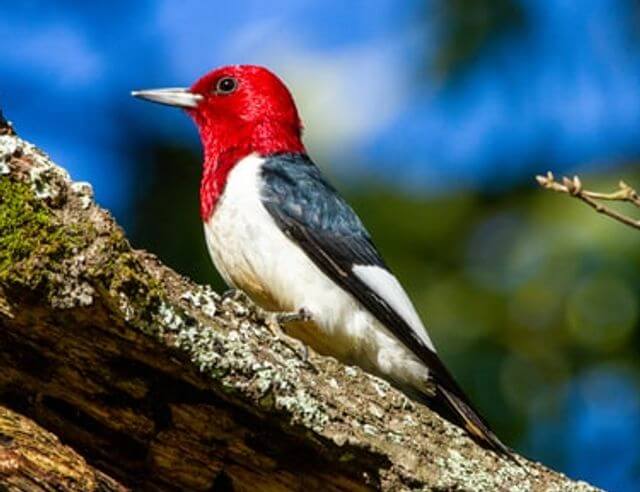
- Length: 7.5-9.1 in (19-23 cm)
- Weight: 2.0-3.2 oz. (56-91 g)
- Wingspan: 16.5 in (42 cm)
- Scientific Name: Melanerpes erythrocephalus
- Frequency of Occurrence: 0.5517%
- Maps: Range map – Sightings map
- Sounds: Calls and songs
- Where To Find Them: The best place to spot a Red-headed Woodpecker may be Rocky Mountain National Park. Here, the woodpeckers can often be seen probing pine and fir trees for insects and larvae. The montane and subalpine forests provide excellent habitat for these birds, with plenty of food sources available year-round. Visitors should look for tall trees with dead branches; this is where red-headed woodpeckers tend to congregate as they search for their meals.
- How to Attract: There are a few steps you can take towards making your yard hospitable for a Red-headed Woodpecker. First, you should place bird feeders like the Grand Cedar Ranch Hopper & Suet Feeder in your yard with suet or sunflower seeds that they prefer. Suet combined with small amounts of cornmeal is an especially attractive treat for the Red-headed Woodpecker. Additionally, birdbaths should be placed in areas where they can easily access water for drinking and bathing purposes.
Description: The red-headed woodpecker (Melanerpes erythrocephalus) is a species of bird found throughout much of North America. They are easily identified by their striking bright red head and back, black wings, and white underparts. This species has an extensive distribution range, occurring from central Canada all the way to the southeastern United States. Red-headed woodpeckers typically inhabit open habitats such as edge woods and crop fields, though they can also be found in suburban parks and gardens.
When it comes to diet, these birds feed mainly on insects, but they have been known to eat fruits, nuts and grain too. Nests are usually placed in cavities carved into dead or dying trees, or sometimes telephone poles or fence posts. The female lays 2 to 6 eggs, which are incubated for 12–14 days before hatching. Red-headed woodpeckers make a great addition to any wildlife garden, as they provide natural pest control while adding a splash of color with their bright red heads!
Related: Interesting Red-Headed Woodpecker Facts (Explained)
American Three-toed Woodpecker

- Length: 8.3-9.1 in (21-23 cm)
- Weight: 1.6-2.4 oz. (44.8-67.9 g)
- Wingspan: 14.6-15.3 in (37-39 cm)
- Scientific Name: Picoides dorsalis
- Frequency of Occurrence: 0.4620%
- Maps: Range map – Sightings map
- Sounds: Calls and songs
- Where To Find Them: The most reliable places for viewing American Three-Toed Woodpeckers in Colorado include Rocky Mountain National Park, White River National Forest, San Juan National Forest and Grand Mesa National Forest. Each of these locations is home to coniferous forests that provide suitable habitat for these birds. Birdwatchers should visit during early morning or late afternoon hours, when the woodpeckers tend to be most active.
- How to Attract: The first step is to provide food for the woodpeckers such as suet cakes, nuts or sunflower seeds that are specifically made for wild birds. Placing feeders like the Grand Cedar Ranch Hopper & Suet Feeder in strategic locations around your yard will help attract the woodpeckers. Next, create nesting sites by providing natural cavities such as holes in dead trees or nesting boxes that mimic their natural environment. Finally, you will need to have ample sources of water nearby; bird baths with shallow edges are ideal for drinking and bathing.
Description: The American Three-Toed Woodpecker is found in the coniferous forests of North America, ranging from Alaska to Nova Scotia and south to northern Georgia. Their diet consists mainly of wood-boring beetle larvae, but they will also eat fruits, nuts, sap, and other invertebrates. As for nesting sites, these birds usually excavate cavities in dead trees or snags near their food source.
They also use abandoned holes made by Northern Flickers or Pileated Woodpeckers. This species may also be seen on utility poles or other artificial structures where there are suitable feeding territories with sufficient decaying wood. These birds have a very agile flight that can take them up to twenty feet into the air in search of food.
Ladder-backed Woodpecker
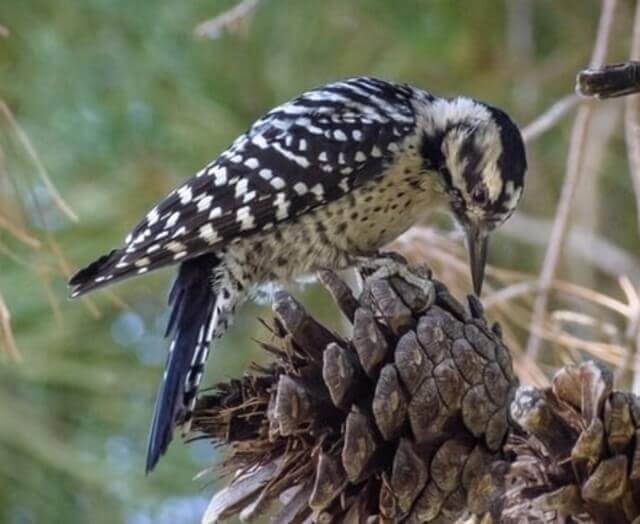
- Length: 5.9-7.5″ in (15-19 cm)
- Weight: 0.71-1.7 oz. (20-49 g)
- Wingspan: 13.0-13.2″ in (33-33.5 cm)
- Scientific Name: Dryobates scalaris
- Frequency of Occurrence: 0.3260%
- Maps: Range map – Sightings map
- Sounds: Calls and songs
- Where To Find Them: One of the best spots for seeing Ladder-backed Woodpeckers is Rocky Mountain National Park. Here you will find plenty of mixed coniferous forests perfect for their habitat needs. The woody shrubs near rivers and streams also provide ideal nesting sites for them to breed during spring months.
- How To Attract: If you want to attract these birds, there are several steps you can take. First, you should know that Ladder-backed Woodpeckers primarily feed on insects, so the kind of bird feeder you choose matters greatly. It’s best to use a Woodlink platform feeder with insect-based seed mix or suet cakes that have high protein levels. There are many different brands available, such as the Wild Delight Suet Cakes, which contain sunflower seeds and dried insects like mealworms and crickets. Additionally, adding items such as fruit pieces or peanut butter may also help draw in more woodpeckers.
Description: The Ladder-backed Woodpecker is a small bird native to North, Central, and South America. Its distribution range extends from southwestern Canada in the north to northern Argentina in the south. It inhabits dry open habitats such as oak or mesquite savannas, ponderosa pine forests, and grasslands as well as urban areas with large trees. Its diet consists mainly of insects that it forages for on tree bark or excavates from dead wood.
When nesting, monogamous pairs excavate a nest hole in a dead tree or beehive; sometimes they nest in cavities created by other birds. The female usually lays four eggs, which take 11–14 days to hatch. Both parents feed the young until fledging occurs at around 24–25 days old.
Red-bellied Woodpecker

- Length: 9.5 in (24 cm)
- Weight: 2.0-3.2 oz. (56-90 g)
- Wingspan: 13.0-16.5 in (33-42 cm)
- Scientific Name: Melanerpes carolinus
- Frequency of Occurrence: 0.1834%
- Maps: Range map – Sightings map
- Sounds: Calls and songs
- Where To Find Them: Rocky Mountain National Park is an excellent place to spot Red-bellied Woodpeckers. The park boasts a variety of habitats that provide perfect perching spots for these birds. The forests of the park are ideal nesting grounds for them, and visitors often spot them pecking away at trees or flying between branches in search of food.
- How to Attract: Choose a large capacity suet feeder, platform feeder or Squirrel Buster feeder. Red-bellied woodpecker love mealworms, but they also enjoy corn chips and sunflower seeds. Place bird baths or water dishes around the area for them to drink from during hot summer days. Bird baths should be shallow, so they can easily access them without getting wet. Finally, hang a few bird boxes in areas of your yard where they can roost at night or raise their young in springtime.
Description: The Red-bellied Woodpecker is a medium-sized woodpecker, found in the eastern and central US. It has an extensive distribution range, ranging from southeastern Canada to Florida and Texas. This species can be found in both deciduous and coniferous forests, as well as parks, suburban gardens and golf courses.
Its diet consists of insects, acorns, seeds and tree sap. The Red-bellied Woodpecker typically nests in dead trees or decaying stumps by drilling holes approximately 15 cm deep for its nest cavity. Nests are reused year after year until the tree begins to decay, at which point it will build a new nest nearby.
Related: How to Attract Red-bellied Woodpeckers to your Yard?
Yellow-bellied Sapsucker

- Length: 7.1-8.7 in (18-22 cm)
- Weight: 1.5-1.9 oz. (43-55 g)
- Wingspan: 13.4-15.8 in (34-40 cm)
- Frequency of Occurrence: 0.0863%
- Maps: Range map – Sightings map
- Sounds: Calls and songs
- Where To Find Them: If you’re hoping to see a Yellow-bellied Sapsucker in Colorado, the best place to spot one is likely at the Rocky Mountain National Park. This park boasts an abundance of coniferous trees which are ideal for this species habitat. During their northern migration, they will often flock in large numbers here, making them easier to spot than other areas. If you miss seeing them at the Rocky Mountain National Park or don’t have access to it, other options include Mueller State Park and Barr Lake State Park.
- How to Attract: Adding a few simple elements to your yard can make it an ideal habitat for the Yellow-bellied Sapsucker. Attracting this eye-catching species of woodpecker can be accomplished by providing ample food sources. Planting trees such as maple, birch, and willow which produce sap that they feed on is one way to entice them into your yard. Additionally, you can add suet feeders with insect suet or Squirrel Buster feeder filled with nuts or berries, as well as bird baths with shallow water that they love to bathe in. Creating nesting sites such as holes in dead trees or nest boxes will also provide a safe place for the birds to call home.
Description: The Yellow-bellied Sapsucker (Sphyrapicus varius) is a medium-sized woodpecker that can be found in the northern and eastern parts of North America. It prefers mature forests with plenty of deciduous trees, such as oaks, maples, and birch, and also coniferous stands like pine and spruce. Their diet consists mainly of tree sap as well as insects, fruits, flowers and buds. They create holes in the bark of certain trees to feed on the sap, which they then drink or store for later use.
For nesting, they typically excavate cavities near the top of dead trees or snags. Both the male and female work together to build their nest, but only the female incubates the eggs during hatching. The Yellow-bellied Sapsucker has become increasingly more endangered due to deforestation, so conservation efforts are being implemented to ensure its survival.
Related: 16 Interesting Sapsucker Facts Revealed! (Photos & Info!)
Acorn Woodpecker
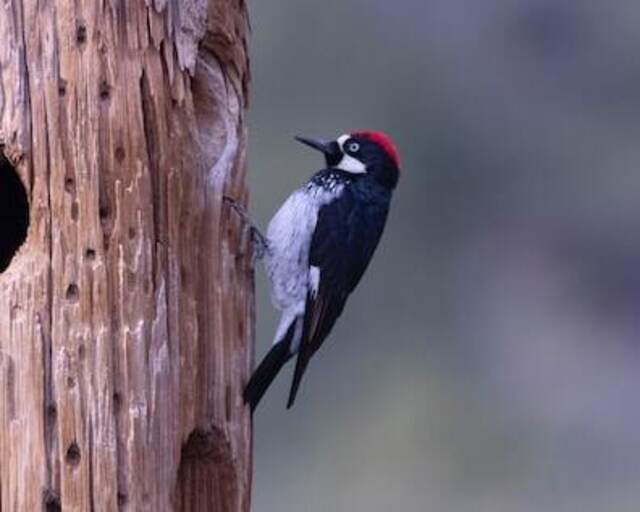
- Length: 7.3-9.4″ in (18.5-24.0 cm)
- Weight: 2.3-3.2 oz. (65-90 g)
- Wingspan: 13.8-17.7 in (35-45 cm)
- Scientific Name: Melanerpes formicivorus
- Frequency of Occurrence: 0.0337%
- Maps: Range map – Sightings map
- Sounds: Calls and songs
- Where To Find Them: The best places where you may have success seeing an Acorn Woodpecker is in northern Colorado around Fort Collins or Rocky Mountain National Park. Both of these areas provide the necessary habitat for Acorn Woodpeckers, including plenty of oak trees for acorns, dead limbs for nesting holes, and easy access to water sources.
- How To Attract: First, plant native trees and shrubs that produce acorn nuts or seeds that acorn woodpeckers love. Oak trees are a favorite, as well as cherry, hickory and beech. If you don’t have space for these types of plants in your yard, providing acorn-filled feeder or platform bird feeders can also entice them. Additionally, leaving dead standing tree trunks in the yard will provide them with a place to perch, peck for insects and even store food for later use.
Description: Acorn Woodpeckers are found along the western United States, from southwestern Canada to Mexico. They live in oak woodlands and coniferous forests, where they feed on insects, acorns, fruit, nuts, sap and even other birds’ eggs. When nesting, Acorn Woodpeckers create large cavities inside dead trees that can be used by many other species of animals.
The colony members will cooperate together to defend their territory during the breeding season. These birds often store food in crevices on tree trunks or in cracks of buildings for later use. A single Acorn Woodpecker may store up to 50,000 acorns per year! With their striking colors and interesting behavior, Acorn Woodpeckers make an exciting addition to any nature-loving home.
Red-breasted Sapsucker

- Length: 7.9-8.7″ in. (20-22 cm)
- Weight: 1.9-2.2 oz. (53.0-63.5 g)
- Wingspan: 14.2-16.0″ in. (36-40.5 cm)
- Scientific Name: Sphyrapicus varius
- Frequency of Occurrence: 0.0147%
- Maps: Range map – Sightings map
- Sounds: Calls and songs
- Where To Find Them: The San Juan National Forest is an excellent location to find Red-breasted Sapsuckers. The area provides plenty of trees with sap holes that encourage the birds to visit and feed on insects such as bark beetles. In addition to this forest, other places where Red-breasted Sapsuckers have been known to frequent include Rocky Mountain National Park and the foothills near Boulder and Denver.
- How to Attract: Begin by creating an inviting habitat for them. Make sure there are plenty of trees in the area that have dead wood with insect larvae that they feed on; as well as suet feeders with suet and other insects like caterpillars or beetles. The presence of water is also attractive; such as water from a waterfall or pond, or even just a bird bath will do the trick! Additionally, providing nesting boxes specifically designed for these type of birds will give them an opportunity to feel safe when visiting your property.
Description: The Red-breasted Sapsucker (Sphyrapicus ruber) is a small woodpecker found in North America. This species has a large distribution range, ranging from the western United States and Canada to Alaska in the north and spanning down into northern Mexico. For habitat, they can be found in coniferous forests, open woodland areas, deciduous woods, orchards and parks.
They mainly feed on tree sap, but they also eat insects such as beetles, ants and wasps that they find while drilling holes in trees for the sap. Red-breasted Sapsuckers typically nest in the cavities of dead trees or stumps near their feeding areas. Both parents are responsible for excavating their nesting cavity and building their nest inside it. The male usually gathers material while the female constructs the nest itself.
Related Post:

